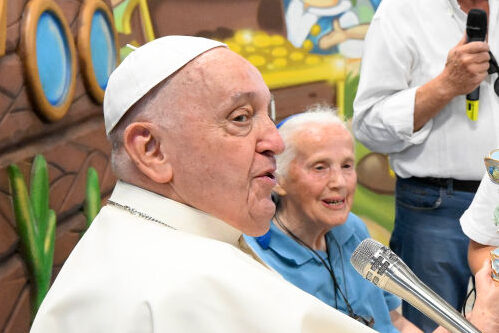
In a moment that broke through the solemnity of Vatican tradition, one quiet act of love captured hearts around the globe.
On April 23, as thousands streamed through St. Peter’s Basilica to bid farewell to Pope Francis, a single figure stepped out of line.
She wasn’t a dignitary or a politician. She was a nun—81-year-old Sister Geneviève Jeanningros — and she wasn’t just there to pay her respects.
The image of Sister Jeanningros standing silently beside the Pope’s casket, tears in her eyes and a green backpack slung over one shoulder, quickly went viral. As clergy and mourners followed strict Vatican protocol, she lingered — breaking formation, but not breaking faith.
A friendship forged in compassion
Pope Francis, born Jorge Mario Bergoglio, died on Easter Monday, April 21, at the age of 88 following a stroke, the Vatican confirmed.
Within 24 hours, more than 48,000 people had visited his coffin. But none made quite the impact that Sister Jeanningros did.
Her name may not be widely known, but her connection to the late pontiff runs deep. The two met more than four decades ago when Francis was Archbishop of Buenos Aires.
Both were devoted to serving society’s forgotten — homeless people, transgender individuals, circus performers, and the terminally ill. Their friendship, built on shared values and mutual respect, endured even after Bergoglio became the leader of the Catholic Church.
“That’s genuine pain,” one user wrote after seeing the video of Sister Jeanningros weeping quietly beside the casket. “This is a historic moment.”
Lives in a modest caravan
Born in France but raised in Argentina, Sister Jeanningros belongs to the Little Sisters of Jesus, an order known for living among and serving marginalized communities. For years, she and fellow nun Sister Anna Amelia Giachetto have lived in a modest caravan on the outskirts of Rome, ministering to society’s outcasts.
Every Wednesday, she would visit Pope Francis — sometimes bringing guests from the streets to meet him. The Pope, never one to stand on ceremony, always welcomed them. Often, he’d invite them to stay for lunch.

She was also no stranger to loss. Her aunt, Léonie Duquet, a French nun, was abducted and killed by Argentina’s military dictatorship during the Dirty War.
Pope Francis, himself the son of Italian immigrants in Argentina, understood her grief — and stood by her in it.
Love over protocol
Many initially assumed Sister Jeanningros had defied Vatican protocol by stepping out of line to approach the coffin. In truth, she had been quietly granted special permission — a rare honor not extended to cardinals or heads of state, but to someone whose bond with the Pope transcended rank.
Photos show her among the crowds — unassuming, wearing a simple outfit and a backpack. But in that moment beside the coffin, she represented something profound: a life spent in quiet devotion, a friendship built not on politics, but on purpose.
One poignant photo shows the Pope and Sister Jeanningros smiling together at an outdoor event, radiating joy. In another, they bless a statue at a circus-themed festival — both lovers of the circus, they believed in its power to uplift.
Her final visit to the Vatican this week wasn’t routine. It was a goodbye.
Proved to be different
“She approached her friend just like she did every other Wednesday,” one user reflected. “This encounter, however, proved to be different. She arrived to say goodbye, hoping to see him again in eternal life.”
In a Church often criticized for rigidity, Sister Jeanningros and Pope Francis stood for something softer: inclusion, mercy, and real-world ministry. Her goodbye wasn’t flashy, and it didn’t need to be. It was quiet, raw, and deeply human, much like the man she came to mourn.
And as her image continues to spread across the internet, one thing becomes clear: Sometimes, the most powerful eulogies aren’t delivered with words — they’re delivered with presence.


